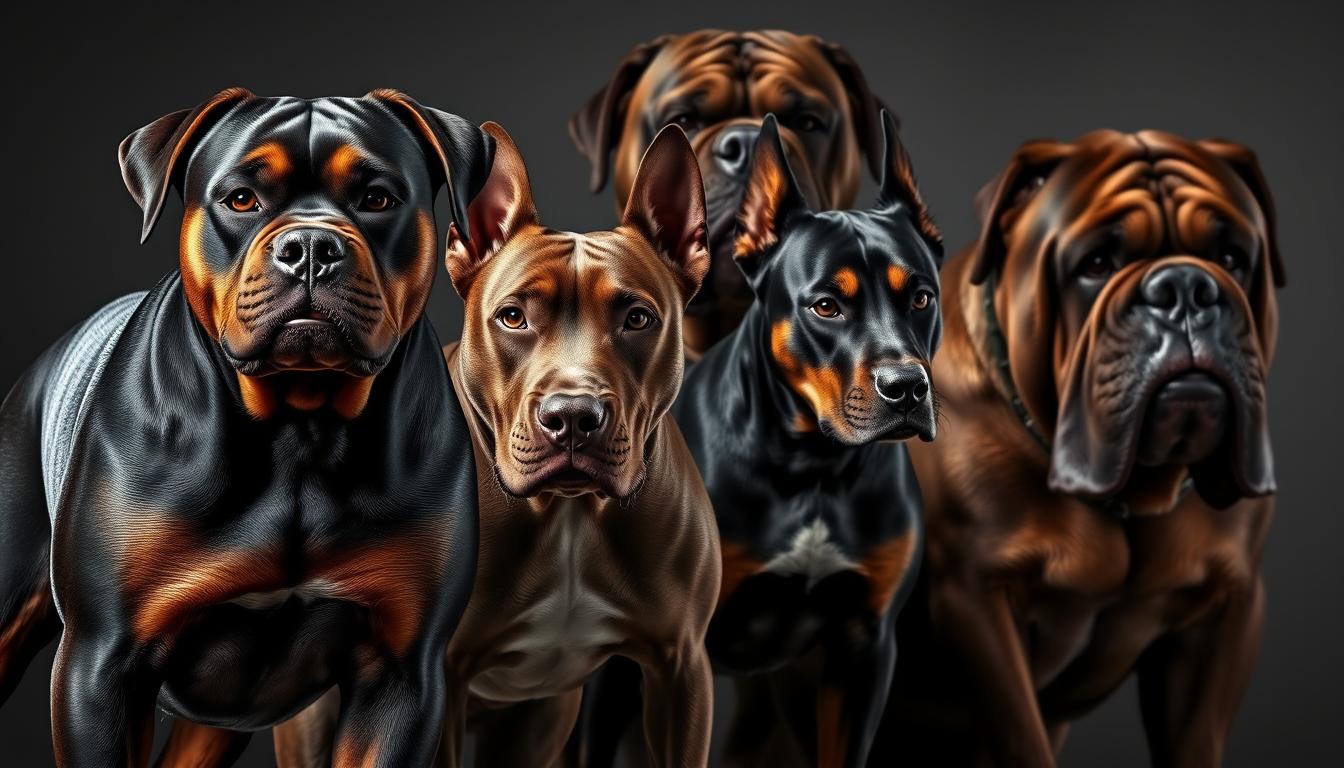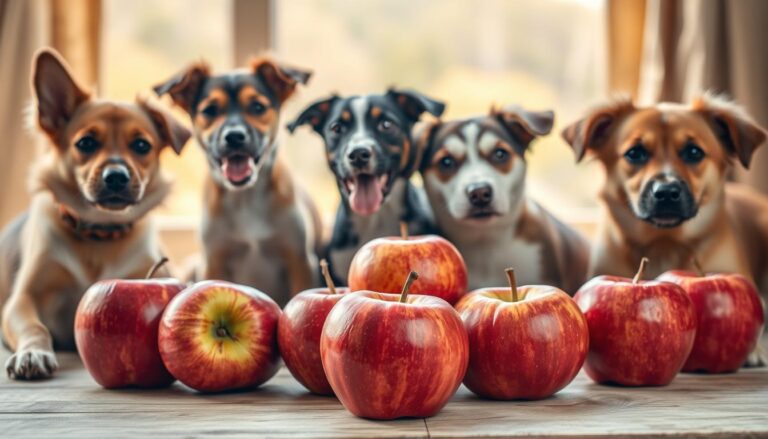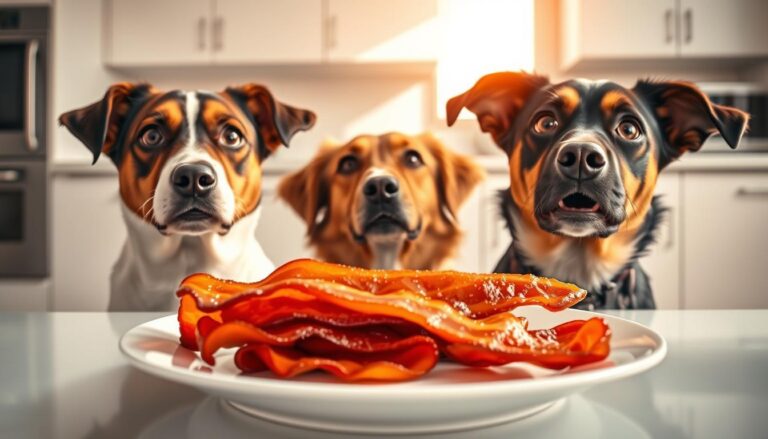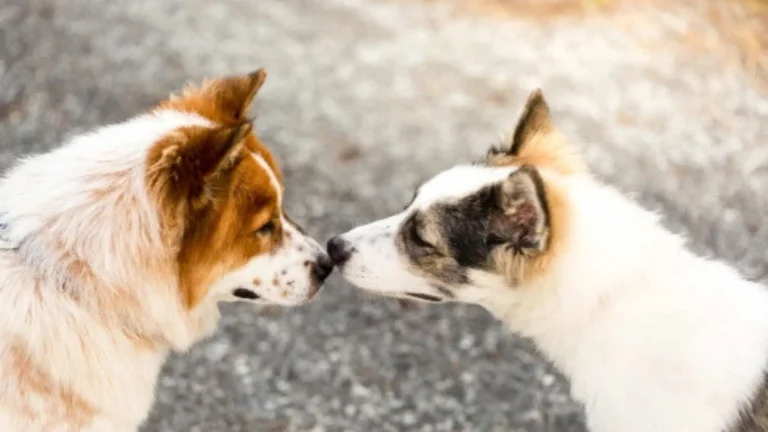Scariest Looking Dogs and Their True Nature
The first time I saw a Rottweiler, my heart skipped a beat. Their strong muscles, deep eyes, and big stance looked scary. But, as I learned more, I found out they’re not as scary as they look.
Many dogs that look intimidating are actually very loyal and gentle. They are often misunderstood. The world of scary-looking dogs is full of surprises.
Our views of these dogs might come from movies and stories. But, they have a lot of love and loyalty to offer. Some of the scariest dogs are actually the best family pets.
This journey into the world of scariest looking dogs will show you the truth. We’ll explore their history, understand their nature, and see why they deserve a second chance. Get ready to rethink everything you thought you knew about intimidating dog breeds.
Table of Contents
Understanding Canine Appearance and Behavior Connection
Dogs are complex creatures. Their appearance often doesn’t match their true personality. Spooky pet dogs might look intimidating, but their behavior is shaped by many factors.
To understand the connection between a dog’s looks and temperament, we need to explore several key aspects. These include canine development and psychology.
Physical Features That Create Intimidating Appearances
Frightening canines often have certain physical traits. These traits contribute to their intimidating image:
- Large muscular build
- Pronounced jaw structure
- Deep-set eyes
- Thick, robust body frame
How Environment Shapes Behavior
Your dog’s environment is crucial in shaping its temperament. Positive training, consistent socialization, and nurturing experiences can change even the most spooky pet dogs into gentle companions.
The Role of Genetics in Dog Temperament
Genetics play a big role in a dog’s behavior. While some frightening canines might have inherited protective instincts, their individual personality development depends on many factors.
“A dog’s behavior is a complex interplay between genetics, environment, and training.” – Canine Behavior Research Institute
Historical Background of Guard and Protection Breeds
Dogs have been vital in protecting humans for thousands of years. Their scary looks were not just for show. They were about survival and keeping safe. Ancient people saw the value in dogs that looked fierce to guard animals, homes, and communities.
The history of guard dogs spans many places and cultures. Each area developed breeds that fit their needs and challenges.
- Mesopotamian regions bred large dogs for military and hunting purposes
- European shepherds developed robust guardian breeds for livestock protection
- Asian cultures created specialized dogs for imperial and territorial defense
Some breeds stand out because of their unique histories:
| Breed | Origin | Primary Purpose |
|---|---|---|
| Tibetan Mastiff | Tibet | Monastery and nomad camp protection |
| Caucasian Shepherd | Caucasus Mountains | Livestock guarding against predators |
| German Shepherd | Germany | Military and police work |
These breeds were more than just scary looks. Their ability to protect came from their genetics and training. This was shaped by their history and how they lived with humans.
“A dog’s appearance can be deceiving – true protection comes from training and understanding.”
Knowing their history helps us see why some dogs look so intimidating. It shows their amazing ability to adapt and connect with humans.
Scariest Looking Dogs: Breaking Down the Stereotypes
Dog breeds often get unfair reputations based on how they look. Breeds that look scary often face misunderstandings. This can make it hard for them to find homes.
Common Misconceptions About Intimidating Breeds
People often judge dogs by their looks, leading to dangerous misconceptions. Dogs with strong builds are often seen as aggressive. But, research shows that a dog’s temperament is influenced by many factors.
- Appearance does not determine a dog’s personality
- Individual training matters more than breed characteristics
- Genetics play a complex role in dog behavior
The Impact of Media Portrayal
“Not all dogs with intimidating appearances are dangerous. Media often sensationalizes breed-related incidents.” – Animal Behavior Expert
News and movies often exaggerate certain dog breeds, causing fear. These stories can lead to unfair laws and discrimination against specific breeds.
Scientific Studies on Breed Temperament
Research shows that dog behavior varies a lot. Things like socialization, training, and environment are key. Genetics can influence behavior, but it’s not the only factor.
By understanding these complex factors, we can make better choices when picking a dog. This helps challenge old stereotypes about scary-looking dog breeds.
Most Powerful Guard Dogs and Their True Nature
When we look at pet dogs with a scary look, some breeds really stand out. These dogs are not just big and strong. They are also smart and very loyal.
Rottweilers, German Shepherds, and Doberman Pinschers are at the top of guard dog lists. Their scary looks hide their true nature. They are loyal and can be trained well, making them great family pets.
- Rottweilers: Muscular build with exceptional strength
- German Shepherds: Intelligent and highly trainable
- Doberman Pinschers: Athletic with sharp protective instincts
It’s important to see beyond their tough looks. Each dog has its own special traits. These traits turn them from potential dangers into loving protectors.
| Breed | Weight Range | Primary Characteristics |
|---|---|---|
| Rottweiler | 80-135 lbs | Powerful, protective, family-oriented |
| German Shepherd | 50-90 lbs | Intelligent, versatile, loyal |
| Doberman Pinscher | 60-100 lbs | Athletic, alert, disciplined |
Getting professional training is key for these breeds. Proper socialization turns their natural guard instincts into safe, reliable actions.
A well-trained guard dog is not just a protector, but a loving family member.
Giant Breeds with Gentle Hearts
Many giant breeds look scary but have gentle hearts. They surprise people with their soft temperaments and love. This shows that size doesn’t mean a dog’s character.
Intimidating dog breeds like Newfoundlands, Great Danes, and Saint Bernards are great family pets. Their big size might look scary, but they are calm and loving.
Training Requirements for Large Dogs
Training big dogs needs patience and consistency. Early socialization and positive reinforcement are key. This helps manage their strength and size.
- Start training early in the puppy stage
- Use positive reinforcement methods
- Establish clear boundaries and commands
- Enroll in professional training classes
Health Considerations
| Breed | Common Health Concerns | Average Lifespan |
|---|---|---|
| Newfoundland | Hip dysplasia, heart issues | 8-10 years |
| Great Dane | Bloat, joint problems | 7-10 years |
| Saint Bernard | Cardiac issues, arthritis | 8-10 years |
Exercise and Space Needs
Large breeds need lots of space and exercise. Your living environment must accommodate their size and energy levels. They need daily walks, moderate exercise, and lots of room to move.
- Provide at least 30-60 minutes of daily exercise
- Ensure access to large outdoor spaces
- Maintain a consistent exercise routine
Working Dogs with Intimidating Appearances

Spooky pet dogs play key roles in jobs that need special skills and focus. Dogs like Belgian Malinois and German Shepherds are great examples. They look scary but are incredibly skilled.
These dogs do well in stressful jobs like police work, military, and security. Their strong bodies and alert looks might scare you. But they use their brains and discipline for their jobs.
- Belgian Malinois: Known for extraordinary agility and precision
- German Shepherds: Versatile working dogs with exceptional tracking skills
- Dutch Shepherds: Highly trainable with intense work ethic
Thinking about these dogs as pets? It’s important to know what they need. They require:
- Consistent mental stimulation
- Extensive physical exercise
- Professional training
- Clear leadership and boundaries
Even though they look scary, these dogs can be loyal and controlled. They just need the right guidance and understanding.
“A well-trained working dog is not aggressive, but purposeful and controlled.” – Professional K9 Trainer
Understanding Bite Force and Its Relevance
Exploring terrifying dog appearances leads us to bite force. It’s key to understanding a dog’s potential. The look of a menacing pet dog often ties to its jaw strength and bite power.
Bite force shows how much pressure a dog can apply with its jaw muscles. It helps us understand the physical abilities of different breeds.
Top Breeds by Bite Force Measurement
Some dog breeds are known for their strong bites. The strongest include:
- Kangal: Approximately 743 PSI
- Cane Corso: Around 700 PSI
- Rottweiler: Roughly 328 PSI
- German Shepherd: About 238 PSI
Factors Affecting Bite Strength
Several things affect a dog’s bite force, such as:
- Jaw structure
- Muscle mass
- Overall body weight
- Breed genetics
Safety Considerations
Knowing a dog’s bite force doesn’t mean it’s aggressive. Proper training and socialization are key to avoiding problems with any dog, no matter its strength.
Bite force is a physical capability, not a predictor of a dog’s temperament or behavior.
Protective Instincts vs. Aggression
It’s important to know the difference between protective instincts and aggression in dogs. Many scary dog breeds were made to guard their families and homes. They have a natural urge to protect.
Protective instincts are good because they show a dog’s loyalty and commitment to their people. These instincts show up in different ways:
- Alertness to potential threats
- Positioning themselves between their family and strangers
- Watchful behavior without unnecessary aggression
Aggression, however, is a dangerous behavior. It’s more than just protecting. It includes:
- Unprovoked attacks
- Excessive barking or growling
- Inability to calm down in non-threatening situations
Your dog’s environment is key in whether their protective instincts turn bad. Proper training and early socialization are crucial for even the scariest-looking dogs.
“A well-trained dog protects without causing harm” – Professional Dog Trainer
Experts say to use positive reinforcement and controlled exposure to different situations. This helps your dog know the difference between real threats and everyday interactions. This way, your protective dog stays loyal without being a danger.
Training and Socialization Importance
Training and socialization are key to making pet dogs friendly. Dogs that look scary often lack proper training and early exposure. This can change them into loving friends.
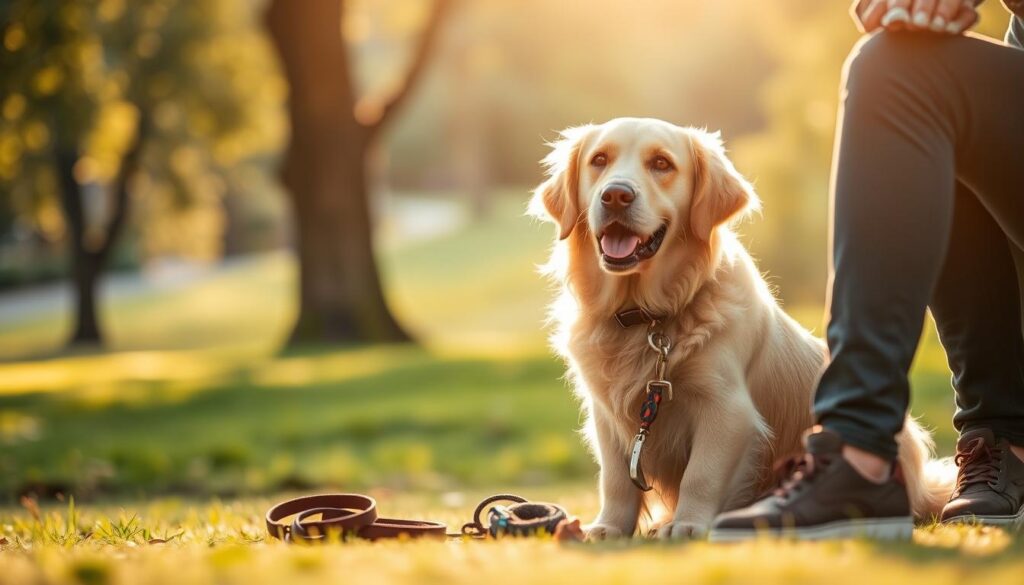
Training is more than just basic commands. It builds confidence and reduces fear. It also helps dogs have positive interactions with others.
Early Socialization Methods
It’s important to introduce puppies to many experiences. This helps them grow into well-adjusted dogs. Here are some key socialization strategies:
- Expose puppies to different people, animals, and environments
- Use positive reinforcement techniques
- Create controlled, safe interaction scenarios
- Start socialization between 3-16 weeks of age
Professional Training Recommendations
Professional trainers are great for dogs with scary looks. Look for trainers who use positive methods. They should know about:
- Positive reinforcement methods
- Breed-specific behavior modification
- Confidence-building exercises
- Impulse control training
Behavior Modification Techniques
Even adult dogs can change their ways. Patience and consistent training are essential. They help turn bad behaviors into good ones.
Remember, no dog is inherently dangerous. With proper training, even the most intimidating-looking breeds can become loving companions.
Living with Intimidating-Looking Breeds
Owning scariest looking dogs needs a lot of effort and understanding. These dogs may look tough, but they can be loving family pets. Success comes from consistent training, socialization, and knowing their special needs.
Here are some important tips for living with intimidating dog breeds:
- Provide extensive socialization from early puppy stages
- Invest in professional training programs
- Maintain strict leash control in public spaces
- Create structured daily exercise routines
- Establish clear behavioral boundaries
Dealing with public perception can be tough for owners of scariest looking dogs. People might feel uneasy or scared around your pet. So, it’s important to manage the situation well. Be an ambassador for your breed by showing how responsible you are and how gentle your dog is.
Mental stimulation is key for these smart, energetic dogs. Use puzzle toys, training, and games to keep them happy. Regular vet visits and training keep them well-adjusted and happy.
“A well-trained dog is a reflection of responsible ownership, not breed stereotypes.”
Remember, every dog is different. By understanding and caring for your dog’s unique personality, you can turn perceived intimidation into admiration.
Legal Considerations and Breed Restrictions
Dealing with the laws of spooky pet dogs can be tough for owners. Breed-specific legislation (BSL) makes rules that affect owners of scary dogs in different places.
It’s key to know the laws in your area. Some cities have rules about certain dog breeds seen as dangerous.
- Muzzle requirements for specific breeds
- Special licensing mandates
- Restricted ownership zones
- Insurance coverage stipulations
The laws about scary dog breeds change a lot by place. Local governments make rules based on safety concerns.
| Breed Category | Common Restrictions | Legal Considerations |
|---|---|---|
| Pit Bull Types | Complete Ban | Strict Licensing |
| Rottweilers | Partial Restrictions | Mandatory Training |
| German Shepherds | Limited Regulations | Controlled Ownership |
Being a good owner means learning about local laws. Talking to local officials and knowing the rules can help you care for your spooky pet dogs.
Responsible ownership goes beyond breed stereotypes and legal rules.
It’s important to speak up and learn about breed laws. Many animal groups fight for fair treatment of all dogs, no matter how they look.
Conclusion
Understanding pet dogs with a menacing look is more than just their scary looks. Your journey shows that looks don’t always tell the whole story. Each dog has its own special traits that need patience, care, and training.
When you see scary-looking dogs, remember that being a good owner is key. With the right training, socialization, and care, even tough-looking dogs can become loving family pets. Breed stereotypes often don’t show the real nature of each dog.
Choosing to have a dog should be a well-thought-out decision. You need to research, see if your lifestyle fits, and be ready to meet the dog’s needs. Dogs with a tough look can be amazing friends if you treat them with love and respect.
Dogs are more than their looks; they have their own personalities. By focusing on their unique traits and training, you can create a strong bond with any dog. The most important thing is to see each dog as a special individual who can bring lots of love and loyalty into your life.

